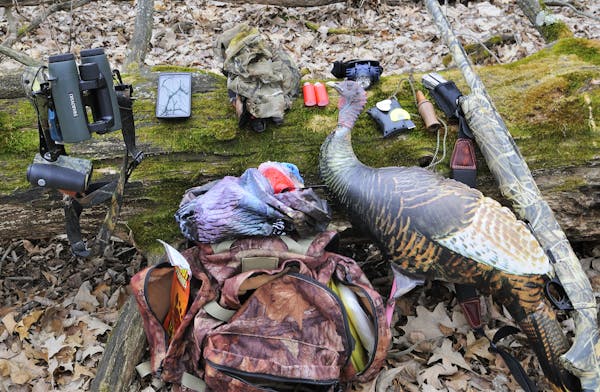Already-amorous tom turkeys are gobbling with gusto in the predawn. Meanwhile, the turkey hunters who will seek them are driving their families crazy, practicing their calling techniques for luring a lovesick tom into shotgun or bow range.
Their worlds collide a half-hour before sunrise April 15, when the first of eight Minnesota turkey seasons this year begins.
To the nonhunter, waylaying a springtime gobbler might appear to be a cinch. After all, turkeys boldly strut, seemingly unconcerned, in the road ditches as we pass in our vehicles. Or romantic toms sometimes strut and gobble in our back yards.
But try to attract a romantic tom on a spring day, and any hunter soon will realize the birds are not as stupid as they appear.
In 1981, I first chased turkeys in extreme southeastern Minnesota. I hunted hard for five days, and I finally bagged a bird on the last day of the season. I lured the turkey into shotgun range by imitating the calls of a hen looking for male companionship.
Now, owing to a successful trapping and transplant program conducted by the Minnesota Department of Natural Resources and the National Wild Turkey Federation, turkeys thrive in the woods and fields near my home south of Brainerd — and points north, too. The birds are undoubtedly a wildlife success story.
At times, bagging a tom turkey is relatively easy. Last spring, when my alarm went off at 4 a.m. on the opening day, I was met with heavy snow and strong wind. After a short drive with windshield wipers on high, I arrived at my hunting location. I had little confidence in calling in a tom. It was a near-blizzard.
Yet, I immediately heard a gobble when I exited my truck. Then another. For whatever reason, at least two toms were actively gobbling.
I dared enter the woods only about 50 yards from my truck for fear of flushing the birds. There I hunkered down in the snow, my back to a tree, my shotgun propped on a knee. Soon I heard the sound of wing beats. The toms flew to the ground from their perches in a big white pine less than 100 yards off.
Using my favorite diaphragm call, I mustered my most seductive yelps. The turkeys responded with thunderous gobbles. After a cat-and-mouse game of roughly 10 minutes, both toms strutted side by side down a logging road and into shotgun range. One of them went home in the back of my truck.
Of course, a turkey in the bag does not always come that easily.
A few years ago I hunted a specific tom for the entire five- day season, and never got within gun range. The turkey was noticeably noisy, often gobbling even during midday. I never saw him with a hen, and his only response to my calling was for him to gobble.
Then, late in the afternoon on the final day of my hunt, he answered my calling. He gobbled and then strutted across a picked cornfield. He was a sight.
I was prone and well-hidden behind a deadfall along the edge of a woodlot. The big, colorful bird suddenly became attentive when he was about 70 yards away. He broke from the strutting position, his head now up and alert. A bad sign.
The tom reversed course and ran all the way across the field and out of sight about a quarter-mile away.
What spooked him? Who knows? I ended that arduous five-day hunt birdless.
Bill Marchel, an outdoors writer and photographer, lives near Brainerd.
